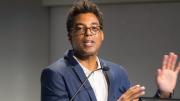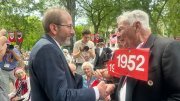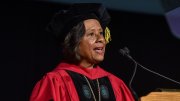As a young artist in the early 1990s, Rick Lowe had just completed a painting about police brutality when a high-school student stopped by his Houston studio. Lowe considered the work as an “exciting moment” in his career, but his visitor had a different reaction: “‘While your paintings and sculptures show what happens in our communities, we don’t need that,’” Lowe, speaking at the Graduate School of Design’s (GSD) Class Day ceremony on May 27, recalled the young man saying. “‘If you’re an artist, and you’re creative, why can't you create a solution?’
On Wednesday, Lowe shared the lessons he has learned from his two decades of work helping build those solutions through art and design. A 2002 Loeb Fellow at the GSD, he is best known as the founder of the arts and culture nonprofit Project Row Houses (PRH), which he started in Houston’s Third Ward in 1993.
Addressing the graduating architects, landscape architects, and urban planners in the GSD’s Piper Auditorium, Lowe posed a question that has been a central tenet of his career as a public artist: As a society, “Who determines what’s valuable—and what’s not?”—whether as a work of art, as a piece of property, as a part of a community. The best design and revitalization projects, he said, upend traditional notions of value by working collaboratively with community members to uncover and make manifest the assets they already have.
He shared the story of the founding of Project Row Houses, which placed a special emphasis on the vernacular form of the “shotgun” house, a local architectural style that housed generations of Houston’s African American population. But by the 1990s, many of these buildings in the city’s Third Ward had been abandoned, and had fallen into disrepair. “Project Row Houses started with an architectural form that basically represented a neighborhood, and this representation of the neighborhood was generally assumed to be one of no value,” Lowe said. But, he continued, “From an artist’s standpoint, there are opportunities to reimagine things.” He and a group of fellow artists began by renovating 22 houses. Two decades later, their work has expanded dramatically, and has been praised as a model of arts-driven neighborhood revitalization—through programming that includes arts studios, mentoring and tutoring initiatives for children, and a residential program for single mothers.
Lowe encouraged the graduates to think critically about the traditional value structures in the arts and design professions, pointing to his efforts to create public arts spaces in Dallas’s diverse Vickery Meadows neighborhood. Inspired by an artist friend’s experience with a London gallery, he thought about how the very act of showcasing art in a contemporary gallery’s “white box” can confer value on a work. Then, as a play on this art-world construct, he worked with architects to design a series of white, 12-by-12-foot cubes that were placed along a main street in Vickery Meadows. The boxes became exhibition spaces for local artists, and offered less obvious utility as well—as public gathering spaces, and even as makeshift shelters for residents waiting for the bus. That experience, Lowe explained, helped him “challenge the notion of public space not necessarily being relevant.”
He also encouraged the graduating class to build on his model of collaborative design, by thinking below the city and neighborhood scale. His best work, he says, has grown out of spending time building individual relationships within communities, helping show local residents how they can contribute to their neighborhood’s ultimate revitalization. “What I’ve learned over time,” he emphasized, “is to not try to do things for people, but try to create situations where they can do it for themselves.”
“People are getting tired of being devalued,” Lowe concluded. “If we can join forces with them, and figure out structures and ways in which we can help them find their sense of value in their own personal lives—but also in their community context—I think that’s the charge for the future.”









